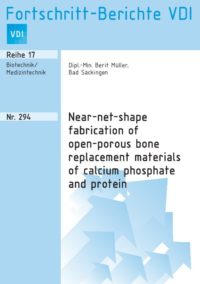Near-net-shape fabrication of open-porous bone replacement materials of calcium phosphate and protein

Erscheinungsdatum: 06.11.2017
Reihe: 17
Band Nummer: 294
Autor: Dipl.-Min. Berit Müller
Ort: Bad Säckingen
ISBN: 978-3-18-329417-6
ISSN: 0178-9600
Erscheinungsjahr: 2017
Anzahl Seiten: 104
Anzahl Abbildungen: 35
Anzahl Tabellen: 4
Produktart: Buch (paperback, DINA5)
Produktbeschreibung
As today’s synthetic bone implants fulfil the requirements for the repair of bone defects only in part continuous research for their improvement is ongoing. This work aims at the fabrication of bone replacement materials with bone-like properties regarding composition, structure, mechanical stability, and resorbability. As appropriate fabrication method, the slurry-based freeze gelation process was chosen. It allows the direct incorporation of active bio-relevant compounds, such as proteins, during scaffold processing. Moreover, the process enables the fabrication of complex-shaped and open-porous scaffolds. As principal components for the scaffolds calcium phosphate and protein were selected as they are biocompatible and resorbable. This work analyses the interaction between calcium phosphate and protein in suspension and investigates the suitability of the fabricated calcium phosphate/protein scaffolds as bone replacement material and drug release depot.
Table of Contents
SUMMARY …………………………………………………………………………………………………………………… VIII
ZUSAMMENFASSUNG ……………………………………………………………………………………………………. IX
1 INTRODUCTION…………………………………………………………………………………………………………… 1
1.1 MOTIVATION ……………………………………………………………………………………………………………… 1
1.2 AIMS OF THIS THESIS ………………………………………………………………………………………………….. 2
2 BASICS ……………………………………………………………………………………………………………………….. 4
2.1 BONE ……………………………………………………………………………………………………………………… 4
2.2 BONE REPLACEMENT ………………………………………………………………………………………………….. 5
2.2.1 Natural bone replacement materials …………………………………………………………………….. 6
2.2.2 Synthetic bone replacement materials ………………………………………………………………….. 7
2.3 BIOFUNCTIONALISATION OF BONE REPLACEMENTS …………………………………………………………….. 9
2.4. CALCIUM PHOSPHATES …………………………………………………………………………………………….. 10
2.4.1 Hydroxyapatite (Ca5(PO4)3OH) ………………………………………………………………………….. 10
2.4.2 β-Tricalcium phosphate (β-Ca3(PO4)2) ………………………………………………………………… 11
2.5 PROTEINS ………………………………………………………………………………………………………………. 12
2.5.1 Bovine serum albumin (BSA) …………………………………………………………………………….. 13
2.5.2 Lysozyme (LSZ) ………………………………………………………………………………………………. 14
3 METHODS …………………………………………………………………………………………………………………. 15
3.1 POWDER CHARACTERISATION……………………………………………………………………………………… 15
3.1.1 Zeta potential ………………………………………………………………………………………………….. 15
3.1.2 Particle size measurement ………………………………………………………………………………… 18
3.1.3 Density …………………………………………………………………………………………………………… 18
3.2 SCAFFOLD FABRICATION ……………………………………………………………………………………………. 19
3.2.1 State of the art…………………………………………………………………………………………………. 19
3.2.2 Freeze gelation process ……………………………………………………………………………………. 19
3.3 SCAFFOLD CHARACTERISATION …………………………………………………………………………………… 20
3.3.1 Scaffold material properties ………………………………………………………………………………. 20
3.3.1.1 Porosity ……………………………………………………………………………………………………………….. 20
3.3.1.2 Mechanical stability ………………………………………………………………………………………………… 21
3.3.2 Scaffolds’ biocompatibility …………………………………………………………………………………. 23
3.3.2.1 Ultraviolet-visible spectroscopy (UV/VIS) …………………………………………………………………… 23
3.3.2.2 In vivo experiments ………………………………………………………………………………………………… 24
3.3.2.3 Antibacterial properties ……………………………………………………………………………………………. 25
4 EXPERIMENTAL …………………………………………………………………………………………………………. 27
4.1 CHARACTERISATION OF CALCIUM PHOSPHATE POWDERS ………………………………………………….. 27
4.2 COMBINED ZETA POTENTIAL / VIS SPECTROSCOPY MEASUREMENTS …………………………………… 28
4.2.1 Material ………………………………………………………………………………………………………….. 28
4.2.2 Methods …………………………………………………………………………………………………………. 28
4.3 SCAFFOLD FABRICATION BY FREEZE GELATION (FG) ……………………………………………………….. 29
4.3.1 Materials …………………………………………………………………………………………………………. 29
4.3.2 Methods …………………………………………………………………………………………………………. 30
4.4 CHARACTERISATION OF HAP/PROTEIN COMPOSITE STRUCTURE …………………………………………. 32
4.5 BIAXIAL FLEXURE STRENGTH TESTING …………………………………………………………………………… 33
4.6 PROTEIN AND CA2+ RELEASE MEASUREMENTS ………………………………………………………………… 35
4.6.1 Quantification of release of HAp/protein scaffolds ………………………………………………… 35
4.6.2 Release reference measurements under bacterial testing conditions ……………………… 35
4.7 IN VIVO ASSESSMENT ………………………………………………………………………………………………… 36
4.8. BACTERIAL TESTS ……………………………………………………………………………………………………. 37
4.8.1 Materials …………………………………………………………………………………………………………. 37
4.8.2 Methods …………………………………………………………………………………………………………. 37
5 RESULTS ………………………………………………………………………………………………………………….. 39
5.1 PROTEIN ADSORPTION ON CALCIUM PHOSPHATE …………………………………………………………….. 39
5.1.1 Physical properties of calcium phosphate powders ………………………………………………. 39
5.1.2 Combined zeta potential / VIS spectroscopy measurements …………………………………. 41
5.2 FABRICATION AND CHARACTERISATION OF HYDROXYAPATITE/PROTEIN SCAFFOLDS……………….. 47
5.2.1 Fabrication process and composite structure ………………………………………………………. 48
5.2.2. Mechanical strength ………………………………………………………………………………………… 49
5.2.3 Protein release ………………………………………………………………………………………………… 52
5.2.4 In vivo assessment ………………………………………………………………………………………….. 53
5.3 FUNCTIONALISATION OF SCAFFOLDS WITH ACTIVE BIOMOLECULES ………………………………………. 56
5.3.1 Scaffold characterisation …………………………………………………………………………………… 56
5.3.2 Bacterial tests………………………………………………………………………………………………….. 59
6 DISCUSSION ………………………………………………………………………………………………………………. 64
6.1 PROTEIN ADSORPTION ON CALCIUM PHOSPHATE …………………………………………………………….. 64
6.2 FABRICATION AND CHARACTERISATION OF HYDROXYAPATITE/PROTEIN SCAFFOLDS ………………… 69
6.3 FUNCTIONALISATION OF SCAFFOLDS WITH ACTIVE BIOMOLECULES ………………………………………. 72
CONCLUSIONS…………………………………………………………………………………………………………….. 76
OUTLOOK ……………………………………………………………………………………………………………………. 78
APPENDICES ……………………………………………………………………………………………………………….. 79
APPENDIX A ………………………………………………………………………………………………………………… 79
APPENDIX B ………………………………………………………………………………………………………………… 80
REFERENCES………………………………………………………………………………………………………………. 81
AUTHOR’S PUBLICATIONS …………………………………………………………………………………………… 93
Keywords: Biocompatibility, Bioresorbability, Bone Replacement, Calcium / Phosphate, Freeze Gelation, Local Drug Release, Lysozyme, Serum Albumin, Zeta Potential, Biocompatibility, Bioresorbability, Bone Replacement, Calcium / Phosphate, Freeze Gelation, Local Drug Release, Lysozyme, Serum Albumin, Zeta Potential
* Der VDI-Mitgliedsrabatt gilt nur für Privatpersonen